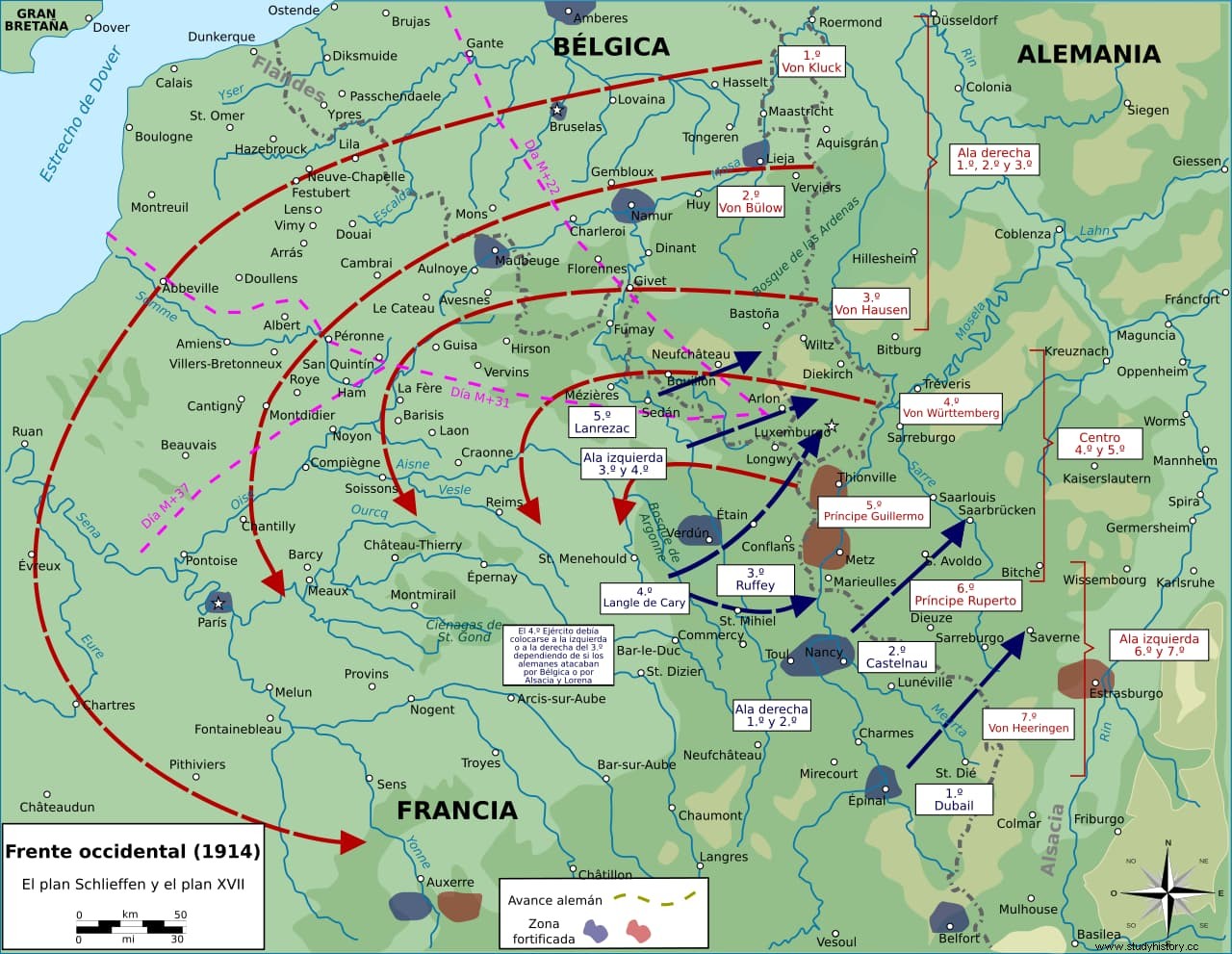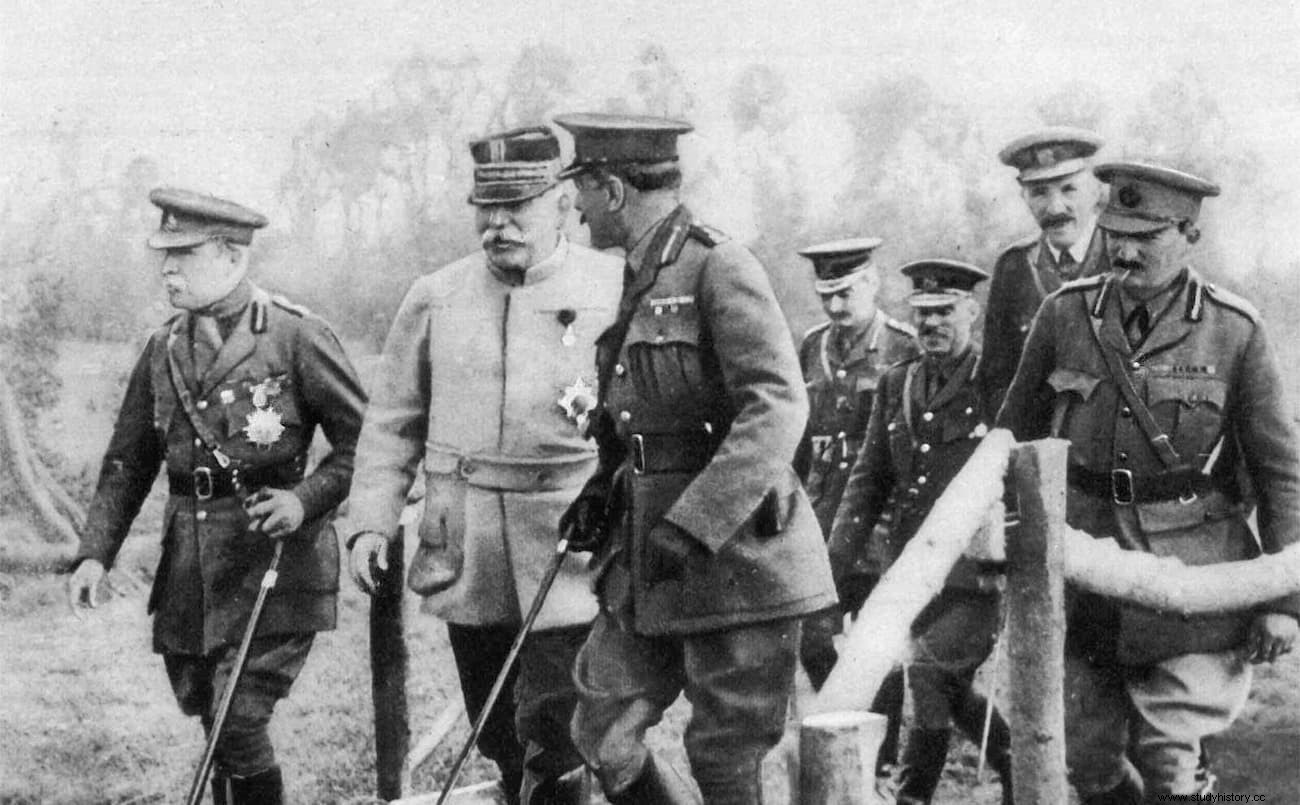On the night of September 7, 1914, the northeast of France became the improvised scene of an unusual spectacle:that of hundreds of taxis that flowed incessantly and hurriedly from Les Invalides in Paris towards the Marne Valley, full of soldiers and each vehicle Following the taillights of the one in front.
The reason was the need to concentrate troops there to stop the German offensive, which threatened to pocket General Manoury's Sixth Army, as an intercepted radio signal had revealed and confirmed by aviation. It was the beginning of what is known as the Battle of the Marne, also called Miracle of the Marne because, against all odds, the enemy was stopped.
The truth is that the picture did not look rosy for the French and their British allies. Since the outbreak of what was the First World War on July 28, a series of offensives and counter-offensives had been developed between the contenders throughout the adjoining territories -which is why they are known as the Battle of the Borders – that obeyed the respective offensive approaches of the contest:the Schileffen Plan Teutonic, whose command was handed over to General Helmut von Moltke, and thePlan XVII Gaul, led by General Joseph Joffre.

The first, baptized with the name of its creator, had as its objective the invasion of France through Belgium and its development was based on the chess premise of sacrificing a piece to achieve checkmate:abandon East Prussia, with the Lower Vistula as limit, to concentrate the largest possible number of troops - a million and a half men - on the Western Front and achieve a quick victory. But Schlieffen died in 1913 and Moltke did not want to risk so much, preferring not to weaken the east so much before the foreseeable Russian attack.
As for the French plan, designed in 1913 from the ideas of Ferdinand Foch, it was based on unrealistic ideas, such as the supposed spirit of the French soldier who was combative by nature and the idea of offensive warfare as the only acceptable one. Its objective was, therefore, to get ahead of the Germans to recover Alsace and Lorraine, lost in 1871, in the Franco-Prussian War.

The forces that he had in that mission were four armies but, as happened to the adversary, this forced him to disarm the north, leaving only one; It was expected that Belgium would act as a buffer, since in addition to violating its territory it would mean for the Kaiser the declaration of war by the British Empire.
And so, one and the other applied their plans. The French, although they initially managed to conquer Mulhouse and Colmar, crashed in The Ardennes, Charleroi and Mons as they encountered more resistance than expected and their troops not only had to abandon what they had gained but were forced to return to the starting point to defend their own territory before the enemy counterattack. Instead, the Germans crossed Belgium almost unopposed - their army had to entrench themselves in Antwerp and Liège - and entered France, threatening to reach Paris at the end of August due to the aforementioned shortage of Gallic troops to defend that sector.
The arrival of the BEF (British Expeditionary Force), the body sent by the British under the command of General John French -indeed, they declared war on Germany on August 4-, was a breath of fresh air. Likewise, the Gallic high command had to redirect part of the Plan XVII forces to the Marne. However, it was still insufficient to stop the Teutonic attack, which penetrated like a knife and had Paris ever closer.

The BEF began to give way in the far north, retreating with the French Fifth Army south to the Oise, Serre, Aisne and Ourq, pursued by von Kluck's First Army and von Bülow's Second. The garrisons at Metz, Thionville, Longwy, Montmédy and Maubeuge were besieged.
On September 2, Von Moltke communicated to Von Kluck and Von Bülow the Grand Directive , an order that they were to forget about Paris, surrounding the city and advancing in stages to focus on pocketing the enemy from the west and destroying them in one blow. However, two things ruined everything.
One was the initiative, as desperate as it was imaginative, taken by the defender of the capital, General Joseph Simon Gallieni, in requisitioning the six hundred and seventy taxis that were available to transport reinforcements to the Marne. Six thousand reservists - five in each vehicle, on two trips - thus carried out that unprecedented motorized transfer of fifty kilometers which, although it had a limited effect given its modest number and poor preparation, did have an effect on a rise in morale in a moment very much in need of her.

The other factor was that Von Kluck did not obey instructions. On September 2, instead of turning west, he continued in a southeasterly direction, which separated him several tens of kilometers from Von Bülow. He also did it without informing his superior until two days later and when he found out he did not answer. Meanwhile, both armies grew further apart until they were about fifty kilometers from each other.
This gap did not go unnoticed by the Allied commanders, who saw in it their last chance and sent two BEF divisions under the command of Lieutenant General Henry Wilson - who was initially reluctant - and the French Fifth Army. General Charles Lanrezac had been dismissed as head of the latter to put in his place Louis Franchet d'Espérey, very popular after having led a cavalry charge with the bayonet while ordering the music band to play La Marseillaise .

Each one had to attack the Germans from a different point, which returned the tactical initiative to the Allies. Gallieni's Sixth Army also joined the plan, the first to intervene by attacking the German IV Reserve Corps at Ourq and stopping it. The Fifth also forced von Bülow back.
In contrast, the BEF, despite having numerical superiority over the enemy, was unable to even approach its objective and would only advance forty kilometers in three days, much to the annoyance of the French. Von Kluck was still confident of success but the arrival of the reservists from Paris (not only in taxis but also in trucks and trains) tipped the balance for the Allied side.
On the night of September 8, in the absence of communications, Moltke sent an aide to see what was happening. This officer confirmed the danger that Von Bülow and Von Kluck would be surrounded and ordered them to retreat. They reluctantly complied with the idea of regrouping in the Aisne department to start a counter-offensive. But, pursued by their adversaries, all they could do was dig trenches and wait. As of September 13, Moltke considered the Schlieffen Plan a failure and, according to legend, even told the Kaiser that they had just lost the war. Joffre would explain it similarly:"I don't know who won the Battle of the Marne, but I know who lost it" .

What really happened was that one phase ended and a very different one began, unexpected and terrible, in which both sides were going to be immobilized and separated by a no man's land for years, unable to break through their respective fronts and with thousands of casualties per the bombings, the machine guns, the gases and the diseases; it was trench warfare:the Marne (in 1918 it was the scene of a second even bloodier battle), the Somme, Verdun...
Speaking of casualties, there was no official count on the Marne and the calculations made by historians are difficult to be precise as more than half a million men participated in total and it was not a single battle but several. In general, it is calculated around eighty thousand French dead, for sixty-eight thousand Germans and seventeen hundred British, although the number of wounded was much higher.
And what happened to the taxis? The day after completing their mission, on September 8, they were mostly demobilized - some were retained to be used as ambulances - and returned to Paris. The most curious thing is that they had been ordered to keep the taximeters running and the French Treasury paid them the corresponding amount, which exceeded seventy thousand francs.

The memory of that peculiar episode lives on in the Musée de l’Armée of the capital, in Les Invalides precisely, where they had met by order of Gallieni. One of those vehicles is preserved there, a Renault AG with the bodywork painted in the characteristic red color that they all wore. Or, as that model has been known ever since, a Marne Taxi.
